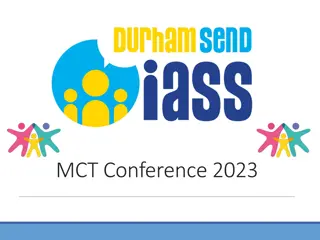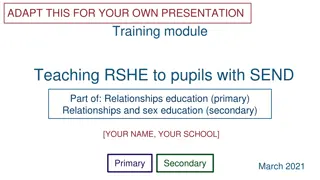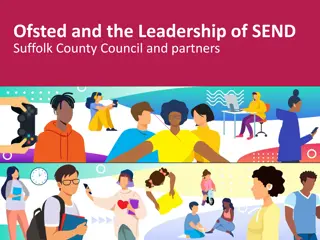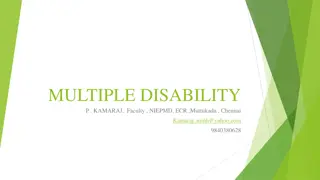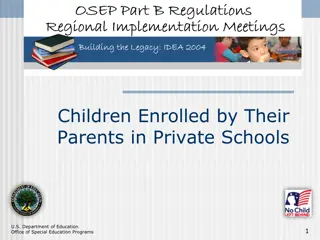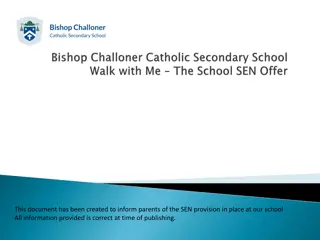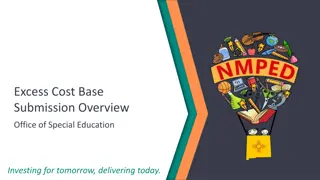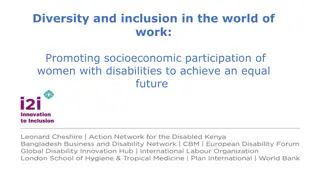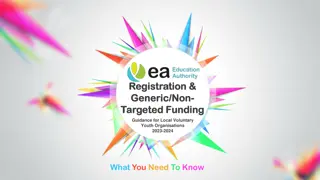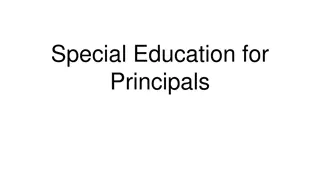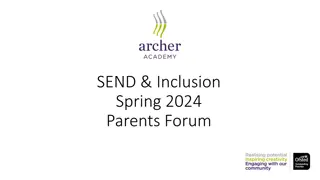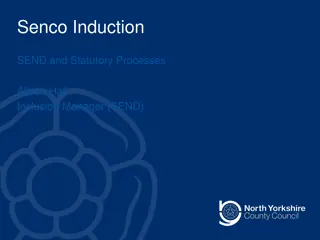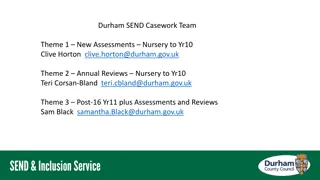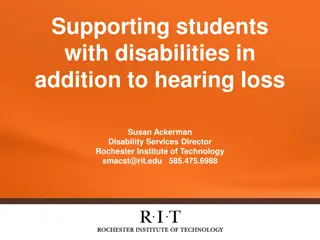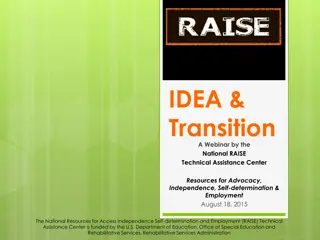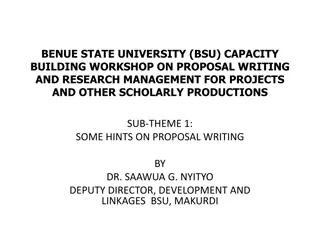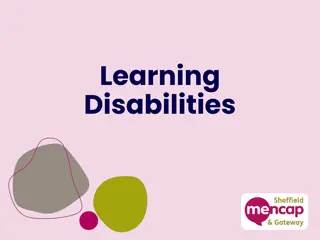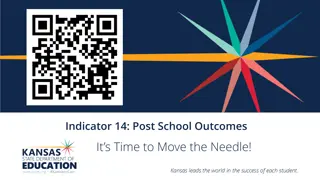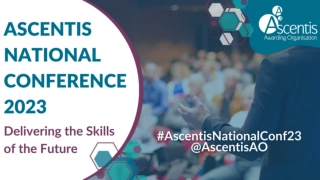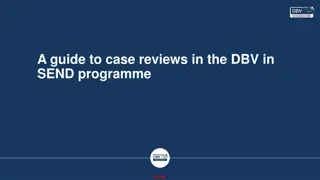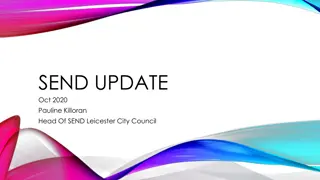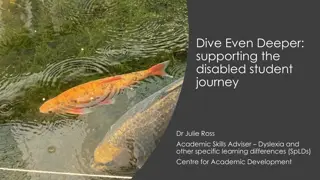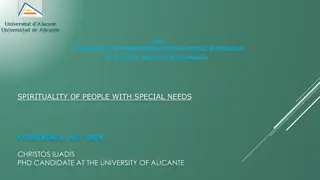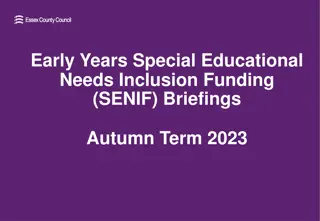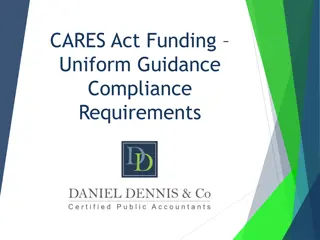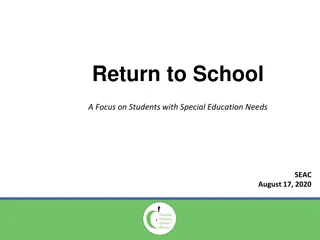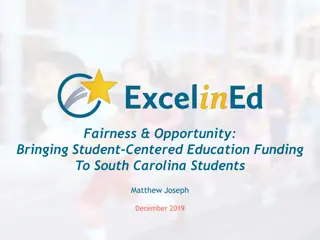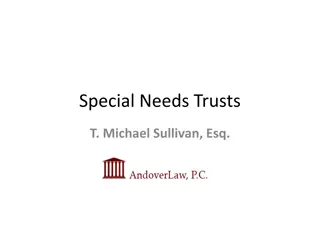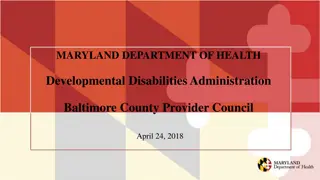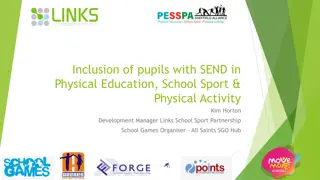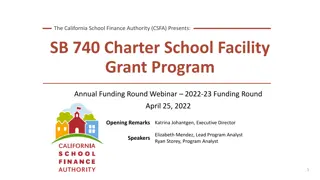Understanding School Funding for Special Educational Needs and Disabilities (SEND)
Explore the funding streams available to support children and young people with SEND in schools, including the National Funding Formula and Dedicated Schools Grant (DSG). Learn how funding is allocated, ways to ensure quality support, and the importance of monitoring spending for strong outcomes. Discover the role of Worcestershire Schools Forum in overseeing funding decisions.
Download Presentation

Please find below an Image/Link to download the presentation.
The content on the website is provided AS IS for your information and personal use only. It may not be sold, licensed, or shared on other websites without obtaining consent from the author. Download presentation by click this link. If you encounter any issues during the download, it is possible that the publisher has removed the file from their server.
E N D
Presentation Transcript
School Funding for SEND www.worcschildrenfirst.org.uk
Aims and objectives To gain an overview of the funding streams made available to schools to meet the needs of children and young people with SEND. To develop a better understanding of how school funding streams should be allocated to provide high quality support as part of the Graduated Response to meeting needs. To explore effective ways of spending SEND funding to ensure strong outcomes for pupils. To promote increased levels of accountability in monitoring and evaluating the impact of spending to ensure value for money. www.worcschildrenfirst.org.uk
National Funding Formula The National Funding Formula is the method that the Government uses to decide how much money should be given to English state schools each year. The National Funding Formula is set out by the Government but is administered by local authorities, who have some flexibility in setting funding for schools in their area. The NFF was introduced from April 2018 with transitional arrangements to support local authorities to embed the formula. All local authorities will have to follow the formula by 2021. www.worcschildrenfirst.org.uk
National Funding Formula (Continued) Description of Figure 1: This is detailed on the previous slide. www.worcschildrenfirst.org.uk
Dedicated Schools Grant (DSG) Dedicated Schools Grant (DSG) divided into three blocks: The schools block - the local authority decides how this money is shared out between schools, using its own funding formula. The early years block. The high needs block. www.worcschildrenfirst.org.uk
The Schools Block The Schools Block (also known as core revenue funding for schools) is one part of the Dedicated Schools Grant, which is paid by the Government to local authorities. It excludes special educational needs funding, early years funding, and the pupil premium. The Department for Education uses the National Funding Formula (NFF) to produce notional allocations for individual schools. Each allocation is then checked against the minimum funding levels and increased if necessary. Following further adjustments, the final notional allocations are aggregated and passed to the school s local authority. The local authority then decides how that money is shared out between schools, using its own funding formula. www.worcschildrenfirst.org.uk
Worcestershire Schools Forum All Local Authorities (LAs) are required to have a Schools Forum constituted in line with the Schools Forum Regulations 2012. Representatives from maintained schools and academies make up the schools forum as well as representation from non-school organisations such as trade unions, diocese authorities, early years providers and 16-19 education providers. Schools forums generally have a consultative role. However, there are situations in which they have decision making powers. Full information about Schools Forum can be found on the DfE website www.worcschildrenfirst.org.uk
Inclusion Funding to Support Children with SEND in the Early Years www.worcschildrenfirst.org.uk
Supporting children with additional needs Statutory Responsibilities All Early Years Providers (Childminders, Nurseries, Preschools, Playgroups, Nursery Classes etc.) must provide support to children with emerging and existing additional needs. They must have clear arrangements in place to support children with additional needs. They have a responsibility to identify children who require additional support at the earliest opportunity, in full consultation with parents and carers. www.worcschildrenfirst.org.uk
Supporting children with additional needs Statutory Responsibilities (Continued) SEND Code of Practice: 5.4 Providers must have arrangements in place to support children with SEN or disabilities. These arrangements should include a clear approach to identifying and responding to SEN. The benefits of early identification are widely recognised identifying need at the earliest point, and then making effective provision, improves long-term outcomes for children. www.worcschildrenfirst.org.uk
Statutory responsibilities Service providers must make reasonable adjustments to include service users with disabilities. (Equality Act 2010) This can include: Changes to environment Providing auxiliary aids Accessing additional services Additional staffing support www.worcschildrenfirst.org.uk
Statutory responsibilities (Continued) Early Years Foundation Stage: 1.6 Practitioners must consider the individual needs, interests, and stage of development of each child in their care. Practitioners must consider whether a child may have a special educational need or disability which requires specialist support. 3.28 Staffing arrangements must meet the needs of all children and ensure their safety. www.worcschildrenfirst.org.uk
Accessing funding to support children with emerging and additional needs in Early Years settings Inclusion Funding is available to all Ofsted registered childcare providers in Worcestershire applications are made through the Early Years Local Inclusion Fund. www.worcschildrenfirst.org.uk
Accessing funding to support children with emerging and additional needs in Early Years settings (Continued) There are 5 levels of inclusion funding within Worcestershire. They are called the Graduated Response Levels: 1, 2, 3, 4 & Exceptional Early Years Funding Each level of funding reflects: The type of needs the child presents with. The type of specialist agencies that are involved with the child. The complexity of need and strategies used to support their development. The staffing support that the child requires. www.worcschildrenfirst.org.uk
Allocating Graduated Response Levels to Children The Early Years settings, in full consultation with parents refer to the SEND Descriptors of Need within the Graduated Response in Education Settings guidance document. They allocate the correct level of funding for the child, and this is paid to them alongside their Nursery Education Funding. www.worcschildrenfirst.org.uk
Graduated Response Levels of Funding EYSFF Inclusion supplement Per hour/per child (max 15 hours) Code of Practice level 2-Year-Old Funding Please note that an automatic supplement for GR1 and GR2 is included within the 2-year-old hourly rate of 5.28 Normal Entitlement NEF hourly rate: 4.20 Included within NEF hourly rate from April 2017: 4.20 Please note that an automatic supplement for GR1 and GR2 is included within the 2-year-old hourly rate of 5.28 Graduated Response 1 Please note that an automatic supplement for GR1 and GR2 is included within the 2-year-old hourly rate of 5.28 Graduated Response 2 NEF hourly rate 4.20 + 0.09 Graduated Response 3 NEF hourly rate 4.20 + 1.60 NEF hourly rate 5.28 + 1.60 Graduated Response 4 NEF hourly rate 4.20 + 2.86 NEF hourly rate 5.28 + 2.86 Exceptional Early Years Funding NEF hourly rate 4.20 + 6.30 NEF hourly rate 5.28 + 6.30 615 annual payment For 3-and 4-year olds in receipt of Disability Living Allowance DISABILITY ACCESS FUND (DAF) Not available to 2-year-olds www.worcschildrenfirst.org.uk
Disability Access Fund and Early Years Pupil Premium Children in receipt of Disability Living Allowance can access an annual payment of 615 called the Disability Access Fund (DAF) it is paid to the childcare setting chosen by the parents in order to help make adjustments to include the child fully. Children aged 3 and 4 may also qualify for the Early Years Pupil Premium which provides Early Years settings with an additional 53p per Nursery Education Funded hour claimed. Settings also receive an additional 10 pence to support children who live in areas of deprivation. www.worcschildrenfirst.org.uk
Planning Appropriate Inclusion Spend Early Years settings are asked to predict what funding they will receive for a term, so that they can spend the funding appropriately from the first day of term. This may include: Additional staffing. Additional visits from specialist agencies. Attendance at SEND training specific to the child or children in their setting. Non contact time to support staff in completing the SEND paperwork. Specific resources to support the child s development. www.worcschildrenfirst.org.uk
Monitoring of funding levels and impact on the child/children The Inclusion Funding is monitored to ensure that the funding is used appropriately, and that there is an impact on the development and outcomes for the child or children. www.worcschildrenfirst.org.uk
Monitoring of funding levels and impact on the child/children (Continued) The funding is monitored in a variety of ways: During routine visits to the Early Years setting by the Inclusion Team. During Nursery Education Funding Audits. Funding levels are reviewed by the inclusion team prior to payment to ensure accuracy. Complaints from parents or other specialists will result in a targeted monitoring visit. www.worcschildrenfirst.org.uk
Monitoring of funding levels and impact on the child/children (Further Continuation) Inclusion funding can be clawed back from Early Years settings if there is evidence that: Funding has not been spent appropriately. There is no evidence of appropriate progress. There is no evidence of inclusion support in place. www.worcschildrenfirst.org.uk
Evidence requirements Early Years settings must be able to evidence the support they have put in place for the children, and the impact of this support on the child s development. This can include: Individual support plans and provision maps. Evidence of child s progress over the term. Observations of the child in setting. Minutes of meeting held with parents and other professionals. Staff rotas demonstrating extra staffing. Receipts for SEND resources. Evidence of SEND training. www.worcschildrenfirst.org.uk
Funding to Support Children with SEND in Schools www.worcschildrenfirst.org.uk
Funding for pupils with SEND in schools SEN funding in Worcestershire is governed by a national framework introduced in April 2013. Elements Funding Core Education Funding Mainstream per-pupil funding (AWPU) (Notionally 4,000 per pupil) Element 1 Additional Support Funding Contribution of up to 6,000 to additional support required by a pupil with High needs from the Notional SEN Budget Element 2 Top Up Funding Top Up Funding from the Local Authority to meet the needs of each pupil placed in the setting Element 3 www.worcschildrenfirst.org.uk
Element 1 Funding Core education funding - an amount of money for each pupil in the school Funding based on the total number of pupils in the school. Every pupil in a school attracts an amount of money. The amount varies from one authority to another. This is the core budget for each school and it is used to make general provision for all pupils in the school including pupils with SEN. www.worcschildrenfirst.org.uk
Element 1: Basic Per Pupil funding The basic per pupil funding for mainstream for 20/21 is: Primary: 3750 KS3: 4800 KS4: 5300 Special Schools receive 10,000 per pupil www.worcschildrenfirst.org.uk
Element 1 Funding Explained This is the funding that is used to run the school staffing, resources, property, site management, services etc. This funding is for all pupils including those with SEND. This will provide all of the ordinarily available provision for all pupils. It will also enable a school to make general SEN provision that might include support staff salaries who are supporting pupils in the classroom. The SENCO salary is also paid from this element. Government guidance indicates that this is notionally 4000 but the actual amount is based on the per pupil funding in the previous slide. www.worcschildrenfirst.org.uk
Element 2: Notional SEN Budget Every school receives an additional amount of money to help make special educational provision to meet children s SEN. This is called the notional SEN budget Based on a formula which is agreed between schools and the local authority. The formula usually gives more money to schools that have more children on free school meals and more children who are not doing as well as others in English and maths. This provides a good guide to how many children with SEN a school is likely to have. The government has recommended that schools should use this notional SEN budget to pay for up to 6,000 worth of special educational provision to meet a student s SEN. www.worcschildrenfirst.org.uk
Element 2: Notional SEN Budget (Continued) This is to provide the additional and different provision (up to 6000 per student) for all pupils at SEN Support. It is also used to provide the first 6000 of support for all children and young people with an EHCP. This funding might be used for one-to-one and small group interventions, specific equipment and resources, training for staff and commissioning of external specialist services. www.worcschildrenfirst.org.uk
SEND Code of Practice 2015 6.95 All mainstream schools are provided with resources to support those with additional needs, including pupils with SEN and disabilities. Most of these resources are determined by a local funding formula, discussed with the local schools forum, which is also applied to local academies. School and academy sixth forms receive a allocation based on a national funding formula. 6.96 Schools have an amount identified within their overall budget, called the notional SEN budget. This is not a ring-fenced amount, and it is for the school to provide high quality appropriate support from the whole of its budget. www.worcschildrenfirst.org.uk
SEND Code of Practice 2015 (Continued) 6.97 It is for schools, as part of their normal budget planning, to determine their approach to using their resources to support the progress of pupils with SEN. The SENCO, headteacher and governing body or proprietor should establish a clear picture of the resources that are available to the school. They should consider their strategic approach to meeting SEN in the context of the total resources available, including any resources targeted at particular groups, such as the pupil premium. 6.98 This will enable schools to provide a clear description of the types of special educational provision they normally provide and will help parents and others to understand what they can normally expect the school to provide for pupils with SEN. www.worcschildrenfirst.org.uk
SEN Support could include, for example: Additional staffing costs. High quality professional development and CPD for staff at all levels. Environmental adaptations. additional tools, resources and/or equipment. interventions or therapy programmes for the individual child. interventions in small groups. www.worcschildrenfirst.org.uk
SEN Support (Continued) focused work with the class teacher, SENCo or other school staff. help for a child to join in class activities or interact with other pupils. Assessments, advice and support from other professionals for the school staff, this could be a specialist teacher, an educational psychologist or a speech and language therapist. Alternative provision. In the GR toolkit you will find a range of different suggestions to meet the needs of the child or young person. www.worcschildrenfirst.org.uk
SEND Code of Practice 2015 (Further Continuation 6.99 Schools are not expected to meet the full costs of more expensive special educational provision from their core funding. They are expected to provide additional support which costs up to a nationally prescribed threshold per pupil per year. The responsible local authority, usually the authority where the child or young person lives, should provide additional top-up funding where the cost of the special educational provision required to meet the needs of an individual pupil exceeds the nationally prescribed threshold. www.worcschildrenfirst.org.uk
Element 3: Top up/High Level Needs funding If a mainstream school can show that a pupil with SEN needs more than 6,000 worth of special educational provision, it can ask the local authority to provide top-up funding to meet the cost of that provision. An EHC Plan will indicate the provision required to meet outcomes and the LA will be expected to fund above 6000. If a special school can show that a pupil s provision will cost more that 10,000 then the local authority will provide top-up funding to meet the cost of the provision. www.worcschildrenfirst.org.uk
LA Top-Up/HLN Funding in Worcestershire BAND BAND CODE ANNUAL TOP UP Ordinarily Available 0 0 Unpredicted U 1200 Exceptional 1 E1 3400 Exceptional 2 E2 5600 Exceptional 3 E3 10300 Exceptional 4 E4 21400 Boarding B 23602 www.worcschildrenfirst.org.uk
The SEN Support for each child will be different because it is designed to meet the needs of each individual child. There are broadly four levels of support available to children and young people, depending on their individual needs. www.worcschildrenfirst.org.uk
Accountability Leaders do not check the impact of the use of the additional funding and provision for pupils with SEND. Therefore, ineffective support continues. Ofsted Inspection Report, 2019 Schools need to be accountable for how they allocate their SEN Notional Budget any Top-up funding received. In what ways do school leaders and SENCos do this? The SEN Information report will indicate what provision the school has in place to support all children and young people with SEND. SENCos should provide an annual report to Governors on SEND provision within the school and how funding has been used to meet the individual needs of pupils with SEND. www.worcschildrenfirst.org.uk
Do you know your schools allocated SEN notional budget? Strengthen partnership working with your school Finance Administrator/ School Business Manager/Bursar. Ensure you access your School Inclusion Profile sent to head@... via the ChS Portal in October and March each year. Audit current spending specific to SEND e.g. specialist support, training, adapted equipment, support staff etc. Does this align with the audit of pupil s needs? Implement ways of measuring pupil progress and evaluating the impact of the spend. Report on impact of the spend to school leaders and Governors. Use evaluations to inform strategic decision making about spending the SEND notional budget. www.worcschildrenfirst.org.uk
Provision mapping SEND Code of Practice 2015 6.76 Provision maps are an efficient way of showing all the provision that the school makes which is additional to and different from that which is offered through the school s curriculum. The use of provision maps can help SENCOs to maintain an overview of the programmes and interventions used with different groups of pupils and provide a basis for monitoring the levels of intervention. 6.77 Provision management can be used strategically to develop special educational provision to match the assessed needs of pupils across the school, and to evaluate the impact of that provision on pupil progress. Used in this way provision management can also contribute to school improvement by identifying particular patterns of need and potential areas of development for teaching staff. It can help the school to develop the use of interventions that are effective and to remove those that are less so. It can support schools to improve their core offer for all pupils as the most effective approaches are adopted more widely across the school. www.worcschildrenfirst.org.uk
Costed Provision Map YEAR GROUP: CLASS: TEACHER: TERM Use this section to explain the way your teachers meet the needs of learners on a day-to-day basis. Include: Differentiation: e.g. visual timetables, key vocabulary, ability grouping Quality teaching Assessment for learning: e.g. steps to success, self-evaluations, Behaviour management strategies: e.g. house points, class rules, Inclusive learning strategies: e.g. number lines, modelling work, tasks broken into smaller chunks INTERVENTION STAFF/CHILD RATIO FREQUENCY PUPILS TOTAL COST TARGET EXPECTED OUTCOME ENTRY DATA EXIT DATA www.worcschildrenfirst.org.uk
Role of Governors One of three core functions: Overseeing the financial performance of the school and making sure it s money is well spent. Ref: Governance Handbook March 2019 Does the Governor designated to oversee SEND know the SEND notional budget allocated for the current academic year? In what ways does the Governing Body evaluate the impact of allocated funds to ensure it is spent well and demonstrates value for money in relation to pupil outcomes? www.worcschildrenfirst.org.uk
Personal Budgets Personal budgets are given in relation to the provision in EHC Plans. LA prepares a personal budget if it identifies a notional amount as available to secure provision which is specified (or proposed to be specified) in an EHC Plan. Parents or young person involved in securing the provision. Indicative figures discussed during the discussions about draft EHC Plan. Can be allocated in a number of ways Direct payment, an arrangement between LA, school, parents or third part arrangements. Optional but LA must prepare if asked to do so. School can veto if in respect of goods and services to be used or provided by school. www.worcschildrenfirst.org.uk
Pupil Premium Funding to raise the attainment of disadvantaged children and young people. Where a disadvantaged student is also identified with SEND this funding should be considered as an additional funding stream to support that student s individual needs. Eligible for free school meals in last 6 years plus children in care of local authority for more than six months. www.worcschildrenfirst.org.uk
Pupil Premium (Continued) From April 2020: 1,345 per primary-aged pupil. 955 per secondary-aged pupil. 2,345 for looked after and previously looked after children. 310 for children of Parents in Armed forces. Year 7 Catch-Up Premium On the 19th June 2020 the DfE announced that it was discontinuing this funding in 20/21 and that it would be part of the National Funding Formula. www.worcschildrenfirst.org.uk
Primary Schools PE and Sports Premium Introduced in 2014 This can be spent on the PE and sports department of any eligible school to increase physical education, active lifestyles and sports for all primary school pupils. Confirmation of this funding from 20/21 was announced on 5th July Primary schools will receive a similar amount to last year. www.worcschildrenfirst.org.uk
Primary Schools PE and Sports Premium (Continued) It was also announced that any underspend from 19/20 could be carried forward. This funding stream may be very useful to support students with SEMH difficulties to support them in accessing the full curriculum. www.worcschildrenfirst.org.uk
COVID-19 Catch-up Premium 650 million of universal catch-up premium funding will be available for all state-funded mainstream and special schools, and alternative provision. DfE will provide funding to local authorities for pupils with education, health and care (EHC) plans who are educated in independent special schools based on the number of such pupils in their area. Each mainstream school will receive 80 for each pupil in years reception through to 11. Special, AP and hospital schools will be provided with 240 for each place. www.worcschildrenfirst.org.uk
COVID-19 Catch-up Premium (Continued) Schools should use this funding for specific activities to support their pupils to catch up for lost teaching over the previous months. Schools have the flexibility to spend their funding in the best way for their cohort and circumstances. School leaders must be able to account for how this money is being used to achieve the central goal of schools getting back on track and teaching a normal curriculum as quickly as possible. www.worcschildrenfirst.org.uk
Where to go for more information SEND Code of Practice 2015 Worcestershire Local Offer Worcestershire Graduated Response Early Years Local Inclusion Fund COVID-19 Catch-up Premium www.worcschildrenfirst.org.uk



